When we mention vitamin D, we tend to think of sunshine and milk. When we mention vitamin K, many people often go, ‘what does that vitamin do again?’.
This article explains the role that these two vitamins play in the body, and how they work together synergistically for optimal health and well-being. We will also take a look at the various methods of supplementation, and how oral vitamin sprays can be helpful for those who suffer from malabsorption or chronic illnesses that interfere with the regular methods of supplementation.
Pin to Your Vitamins & Nutrition Boards for Reference:

*Disclaimer: Whilst this post is sponsored by Spectra Spray, all opinions expressed are my own. I am not a doctor; this article is just a rough guide, and nothing should be taken as a medical advice. Always consult your own doctor before you start on any new treatment or protocol. This post contains affiliate links. It will cost you nothing to click on them. I will get a small referral fee from purchases you make, which helps with the maintenance of this blog. Read our Privacy Policy page for more information. Thank you!
-
Changelog:
- 1 June 2025: Reference and link updates, and minor layout fixes.
Types of Vitamin D (Vitamin D2 & Vitamin D3)
In general, vitamin D is both a nutrient we eat or take, and a hormone that our body makes. It comes in two forms - vitamin D2 (ergocalciferol) and vitamin D3 (cholecalciferol) (Harvard T.H. Chan School of Public Health, 2023). When we refer to the “sunshine vitamin” or to vitamin D in general, we are mostly referring to vitamin D2 (Nair & Maseeh, 2012).
Certain medications can interaction with vitamin D, such as orlistat, statins, steroids and thiazide diuretics (Office of Dietary Supplements [ODS], 2024). It is a fat-soluble vitamin, meaning that it is stored in body fat. Vitamin D toxicity is a possibility if we overdose on it. This can lead to hypercalcemia and hypercalciuria. Symptoms include nausea, muscle weakness, neuropsychiatric disturbances, kidney stones, renal failure and more (Marcinowska-Suchowierska et al., 2018).
For the reasons listed above, it is important to discuss with your doctor before taking any supplements.
Types of Vitamin K (Vitamin K1 & Vitamin K2)
Vitamin K is also a fat-soluble vitamin. It comes in the forms of vitamin K1 (phylloquinone), and vitamin K2 (a series of menaquinones). Compared to other fat-soluble vitamins, very little vitamin K actually circulates within the blood. It is rapidly metabolised and excreted (ODS, 2021).
Experts believe that the absorption rate is a little better for vitamin K2, as it is often found in foods that contain fat. In addition, vitamin K2 has a longer side chain. This allows for a longer circulation time in the body as compared to vitamin K1. There is also a third synthetic form - vitamin K3 - known as menadione. It is no longer used in dietary supplements as lab studies have shown that it damages hepatic cells (ODS, 2021).
The Basic Roles of Vitamin D
Vitamin D helps with the absorption and retention of the minerals, calcium and phosphorus, in the body. These are essential 'materials' for the body to build and maintain healthy bones (National Center for Biotechnology Information [NCBI], 2025). It also has a role to play in cardiovascular disease, as it helps to regulate blood pressure, vascular cell growth, inflammatory and fibrotic pathways.
Studies have also shown that vitamin D may play a positive role in (ODS, 2024):
- Controlling infections
- Reducing inflammation
- Inhibiting carcinogenesis
- Slowing tumour progression
According to the ODS (2024), some studies have also shown a correlation of low vitamin D levels in patients with Multiple Sclerosis (MS). But there are no concrete results from clinical trials so far, for disease management or prevention of MS. What is interesting is that many of the body's organs and tissues have receptors for vitamin D. This suggests that vitamin D plays important roles beyond bone health, although scientists are still trying to figure that out.
Vitamin D2 is approved for the treatment of: hypoparathyroidism, vitamin D-resistant rickets and hypophosphatemia (RxList, 2023). Vitamin D3 is commonly used in dietary supplements to aid with calcium absorption. Studies have shown that vitamin D3 can be superior in raising the body's stores of vitamin D (Heaney et al., 2011).
The Basic Roles of Vitamin K
Vitamin K plays a few important roles in the body, such as: blood clotting, and the prevention of osteoporosis and coronary heart disease. Without vitamin K, the proteins that depend on it for blood clotting cannot form. This can lead to excessive bleeding (Linus Pauling Institute [LPI], 2022).
Vitamin K is a cofactor of gamma-carboxylation of many proteins, including osteocalcin, one of the main proteins in bone (Halder et al., 2019). Osteocalcin is produced during osteoblasts. These cells build up the skeleton during the remodeling process. Newly made osteocalcin is inactive, and requires vitamin K2 to activate it, and for calcium to bind (Vermeer et al., 1995).
Apart from that, the matrix GLA protein (MGP) is vitamin-K dependent. This protein prevents the calcification and stiffening of arterial walls and soft tissue from the accumulation of calcium. Vitamin K2 is much more efficient than vitamin K1 for this purpose, due to the way they are metabolised. As such, many experts believe that vitamin K is necessary for bone growth and development, too (Paakkari, 2016; Theuwissen et al., 2012).
Where to Get Your Daily Dose of Vitamin D
Most of the vitamin D that Americans take comes from fortified foods in their diet, as few foods naturally contain vitamin D. For example, infant formula in Canada and the U.S. needs to contain a minimum requirement of vitamin D. The same goes for milk in Canada as well (ODS, 2024).
Vitamin D2 mainly comes from plant-based sources such as: mushrooms grown in UV light. It is also taken in the form of fortified foods and dietary supplements. Vitamin D3 mainly comes from animal-based sources such as: oily fish, egg yolks, butter, liver and also from dietary supplements (Arnarson, 2023).
Vitamin D3 is also produced by our skin when exposed to UVB (ultraviolet B) radiation from the sun. The benefit of obtaining vitamin D from sunlight is that you can't overdose on it; your skin simply produces less of it if the body already has a sufficient supply (Arnarson, 2023).
A few things to note if you do plan to spend more time in the sun: wear sunscreen, especially when the sun is at its hottest, as overexposure to UV light can lead to other health problems such as skin cancer. You should also be exposed to sunlight outdoors and not indoors behind a glass panel, as glass blocks out the UV rays (Arnarson, 2023).
Where to Get Your Daily Dose of Vitamin K
Vitamin K1 is the predominant form of vitamin K found in the human diet. It can mainly be found in green leafy vegetables such as spinach and kale. And also in broccoli, vegetable oils and some fruits (Zhang et al., 2021).
Vitamin K2 from food varies by subtype, and can mainly be found in fermented foods and animal-based sources. MK-4 is the only subtype of vitamin K2 that is not produced by bacteria. It can be found in some animal products such as chicken, egg yolks and butter (Zhang et al., 2021).
Other subtypes of vitamin K, from MK-5 through MK-15, have longer chains, and are produced by bacteria. They can mainly be found in fermented foods. Natto is a form of fermented soybeans which is particularly high in MK-7. Some cheeses also contain a good amount of vitamin K2 in the forms of MK-8 and MK-9. Some recent studies have also shown pork products to contain vitamin K2 in the forms of MK-10 and MK-11, although such long chains provide little vitamin K activity and are poorly absorbed (Zhang et al., 2021).
Almost all menaquinones are also produced in the body within the gut. You can find a list of common foods that contain vitamin K on the ODS website (2021).
Pin to Your Vitamin D & Vitamin K Boards:
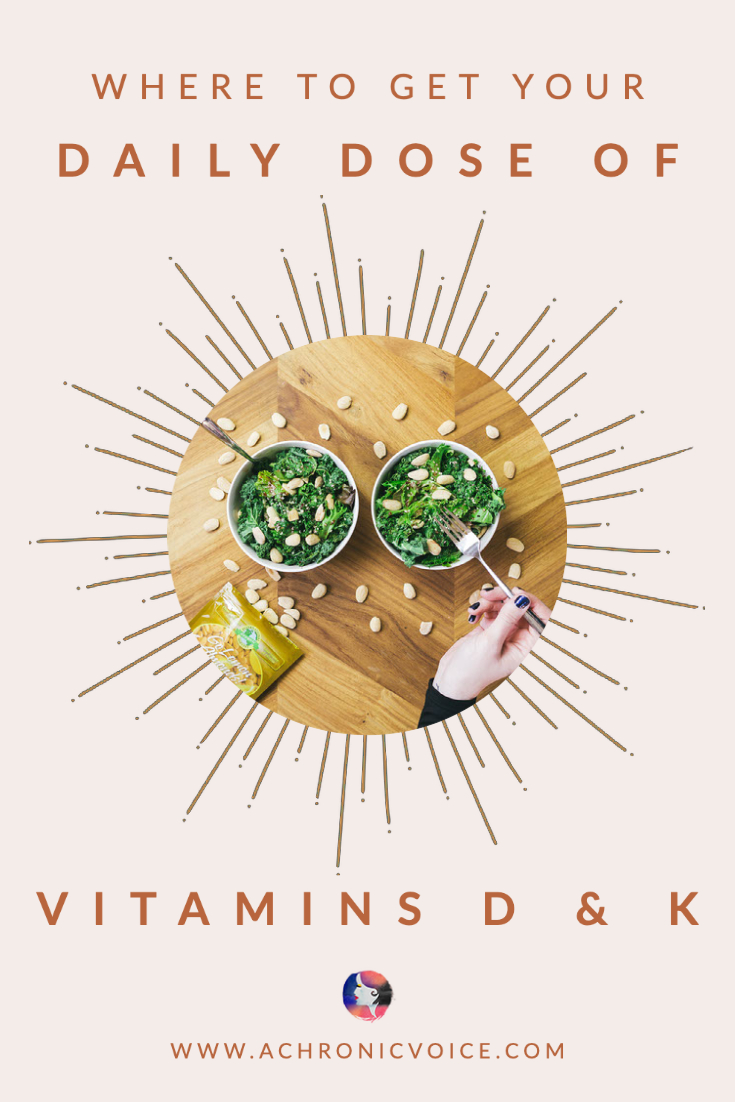
Causes of Vitamin D Deficiency
According to Yale Medicine (n.d.), a few contributors to vitamin D deficiency include:
-
Limited exposure to sunlight. This could be a result of spending too much time indoors, living in a place where there is limited sunlight, or aging, where the skin's ability to synthesize vitamin D from the sun decreases.
-
Malabsorption. This could be due to a chronic illness that affects the gut such as IBD, Ulcerative Colitis, Crohn's Disease, Celiac Disease and more. As vitamin D is fat-soluble, its absorption is very much dependent on the gut’s ability to absorb dietary fat.
Malabsorption of vitamin D could also be due to health conditions that limit fat absorption, or from gastric bypass surgery. Such conditions hinder the process by not allowing the body to produce enough vitamin in time. Or the body is simply unable to absorb it for utilisation.
-
Food allergies or intolerances. Inability to consume vitamin D rich foods due to food allergies or lactose intolerance.
-
Incomplete diet. Simply not consuming enough of it in your regular diet.
-
People with dark skin. The pigment that gives skin its dark colour contains more melanin, which lowers vitamin D production.
Fascinatingly, whilst Black Americans tend to have lower vitamin D in their bodies, they also seem to have lower rates of bone fractures and osteoporosis, as compared to White Americans. Studies about this are still ongoing.
-
Obesity.Those who are obese may need to take higher amounts of vitamin D as compared to those of a regular weight. This is because greater amounts of subcutaneous fat store away more vitamin D.
-
Some babies and infants who are exclusively breastfed. Breast milk does not normally contain a sufficient amount of vitamin D that meets the requirements. This is also dependent on the mother's own supplementation of vitamin D as well.
Consequences of Vitamin D Deficiency
Vitamin D Deficiency in Children
Vitamin D deficiency can be a serious problem in children. Rickets can develop, where bone tissue fails to mineralise properly. This can result in soft bones and skeletal deformities. This then leads to chronic pain, failure to thrive, developmental delay, dental abnormalities, and a whole host of other health problems, some of which become permanent disabilities (Bordelon et al., 2009).
Vitamin D Deficiency in Adolescents & Adults
Vitamin D deficiency can present as osteomalacia in adolescents and adults. This is where existing bone does not mineralise properly during the remodelling process. This can lead to weaker bones that fracture easily. Symptoms may be similar to that of rickets (Bordelon et al., 2009).
Osteoporosis, Vitamin D & Calcium
Bone is living tissue that is constantly being remodeled in the body, and the rate of remodelling slows down as we age. Osteoporosis means 'porous bone', and is a bone disease which causes bones to become brittle and weak (Mayo Clinic, 2024). At its worst, even a cough or sneeze can cause a fracture. Osteoporosis is a major health problem in the U.S., with over 53 million Americans suffering from it, or who are at risk for it (Hoggard & Jeray, 2022).
Vitamin D deficiency alone can lead to rickets or osteomalacia. A lack of vitamin D also reduces calcium absorption. Both vitamin D and calcium need to be taken into account as factors for the development of osteopenia and osteoporosis.
Pin to Your Vitamin D, Nutrition & Health Boards:

Causes of Vitamin K Deficiency
According to Johnson (2024), a few causes of vitamin K deficiency include:
- Malnutrition or extremely inadequate intake of vitamin K from food.
- Fat malabsorption, especially due to diseases that impair this process such as: Cystic Fibrosis, Celiac Disease, Crohn's Disease and Chronic Pancreatitis.
- Liver diseases that decrease storage of the vitamin.
- Decreased production of the vitamin in the intestines.
- Use of anticoagulants, such as warfarin (brand names: Coumadin or Jantoven).
- Use of medications that interfere with vitamin K such as certain antibiotics, antacids and anti-seizure drugs.
- Breastfed infants. In fact, there is a deadly disease known as VKDB (Vitamin K Deficiency Bleeding) which affects some newborns in the first few days of life (Children’s Hospital of Philadelphia, n.d.).
Consequences of Vitamin K Deficiency
A deficiency in vitamin K can interfere with blood clotting processes in the body. This can lead to excessive bleeding that may not stop. (I know this from firsthand experience as I have a blood clotting disorder myself, Antiphospholipid Syndrome, and am on warfarin.)
Pin to Your Vitamin K, Nutrition & Health Boards:

The Synergistic Effect of Vitamin D & Vitamin K2
Whilst both vitamin D and vitamin K play specific and important roles in the body, they also work together synergistically. For one, they work together to enhance and regulate calcium metabolism. Vitamin D promotes the production of vitamin-K dependent proteins in the body. These proteins need vitamin K for carboxylation - a chemical reaction - in order to function properly (van Ballegooijen et al., 2017).
Calcium is needed not only for good bone health, but also plays a role in heart, muscle and nerve functions, and blood clotting. Recent scientific evidence however has also shown that taking too much calcium supplements may increase the risk for heart disease significantly, due to a variety of possible factors, such as overcirculation and coagulation (Myung et al., 2021).
This is where vitamin K2 comes in. The risks for arterial calcification and heart problems can be significantly lowered with at least 32mcg of vitamin K2 present in the diet. However, the typical Western diet contains insufficient amounts of vitamin K2 to activate enough MGP to do so (Maresz, 2015).
Pin to Your Vitamin D, Vitamin K2, Health & Wellness Boards:
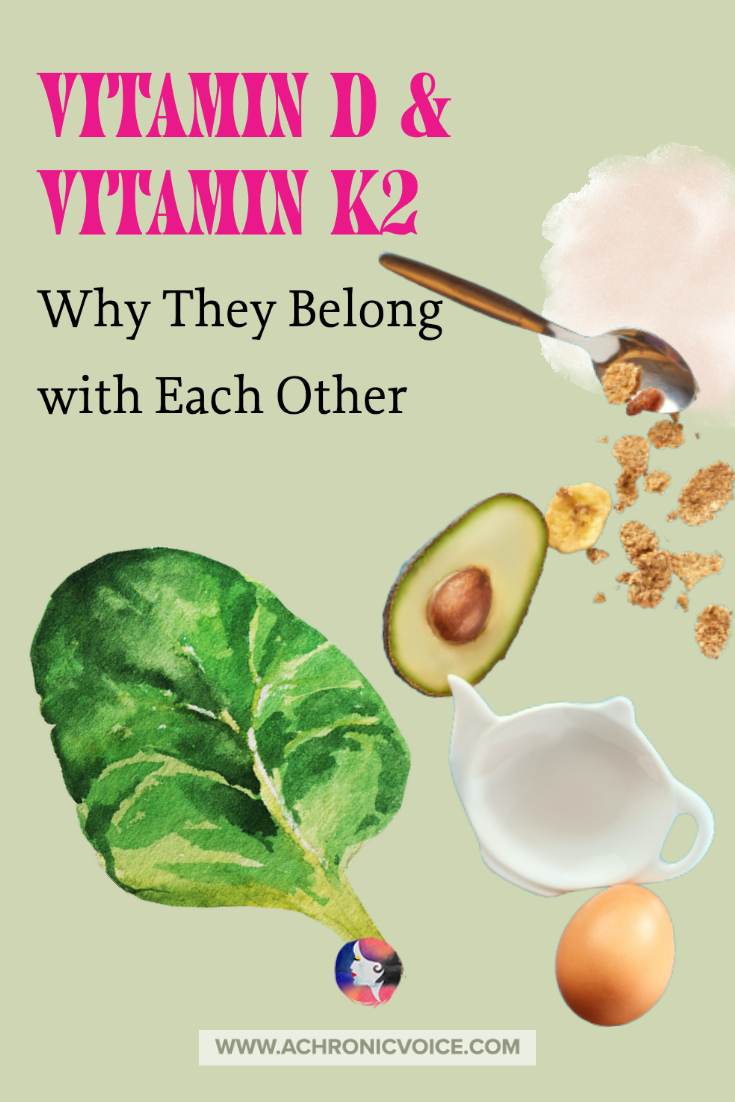
Vitamin D & Vitamin K2 Supplements
Vitamin D3 with vitamin K2 supplements come in a variety of forms. From the slowest to fastest absorption rate (SpectraSpray, n.d.):
- Pills
- Gel capsules
- Sublingual liquids
- Intravenous
- Oral vitamin sprays
Oral Vitamin Spray Supplements
Oral vitamin sprays have the fastest absorption rate because the ingredients have already been emulsified (Satia et al., 2015). This means that body does not need to do extra work to break them down. SpectraSpray’s supplements also contain no binders, fillers, dyes or artificial flavouring, which is good news for those who have allergies to them.
Oral vitamin sprays are great for the convenience and ease of use. All you need to do is to spray them on the insides of your cheeks, hold and swallow. They can be particularly useful as a means of vitamin D plus vitamin K2 supplementation for those who have gut or fat absorption problems. They are also useful for those with chronic illnesses who are unable to take traditional forms of supplements.
Spectra Spray has a fantastic range of oral vitamin sprays for this purpose, including a vitamin D with vitamin K2 oral spray.
Pin to Your Supplements, Nutrition, Vitamin D & Vitamin K Boards:
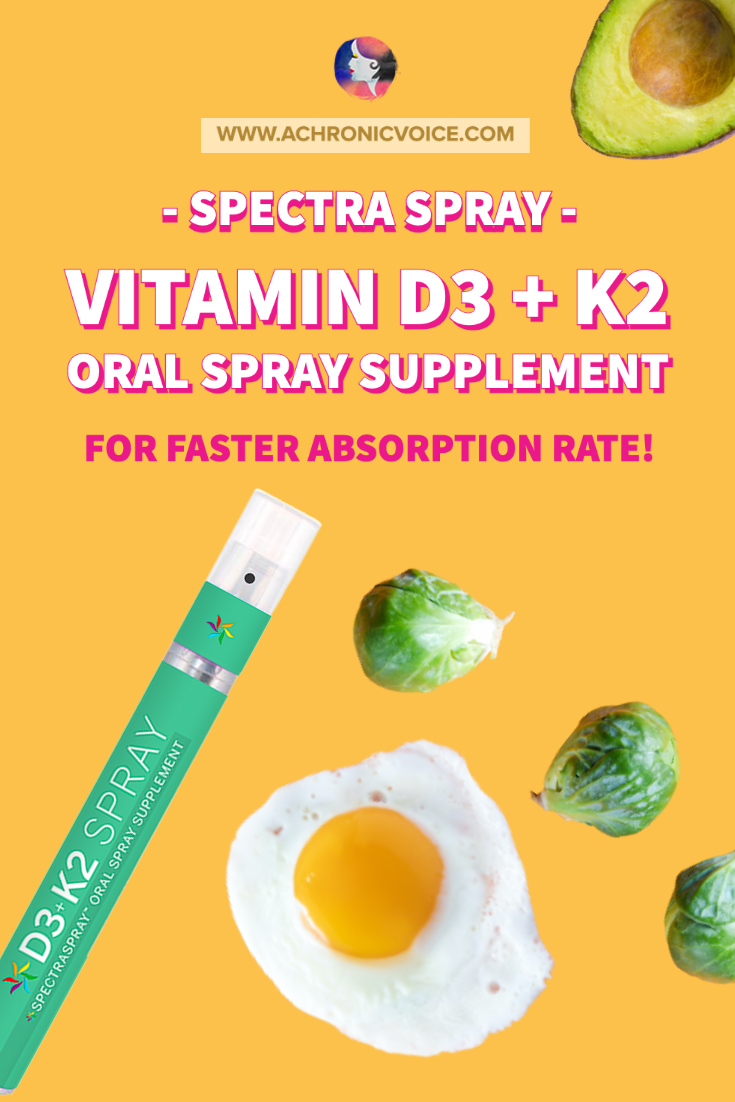
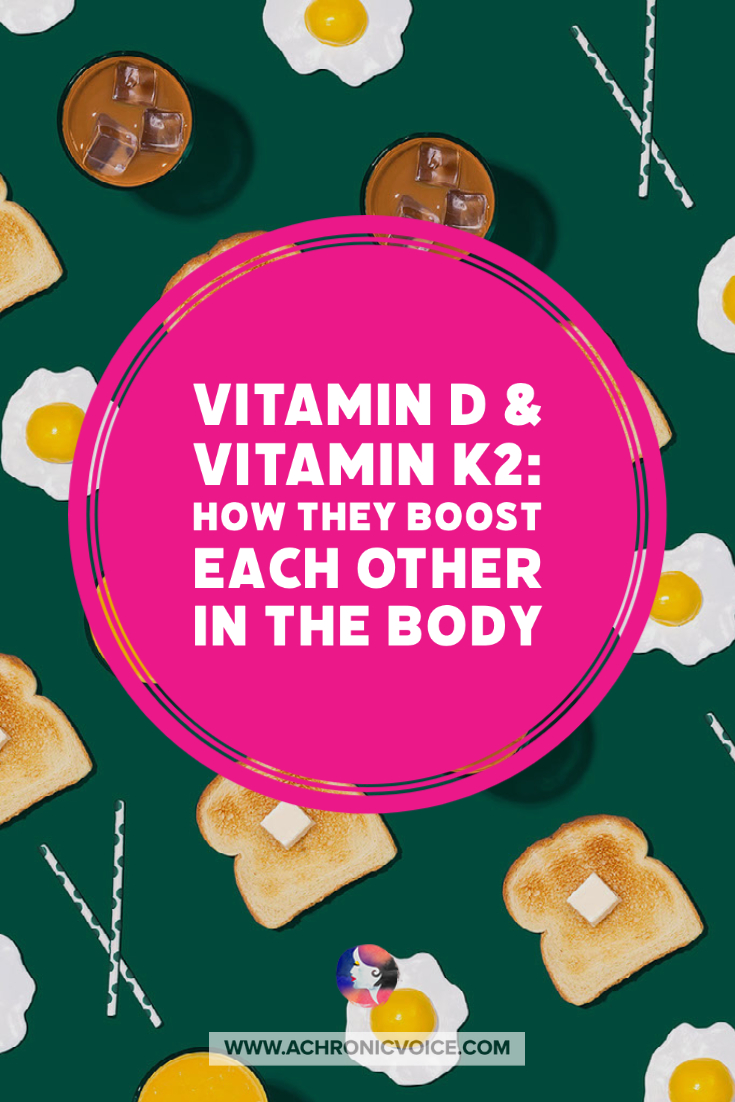
- Arnarson, A. (2023, March 31). Vitamin D2 vs. D3: What’s the difference? Healthline. https://www.healthline.com/nutrition/vitamin-d2-vs-d3
- Bordelon, P., Ghetu, M. V., & Langan, R. (2009). Recognition and management of vitamin D deficiency. American Family Physician, 80(8), 841–846. https://www.aafp.org/pubs/afp/issues/2009/1015/p841.html
- Children’s Hospital of Philadelphia. (n.d.). Vitamin K deficiency bleeding (hemorrhagic disease of the newborn). Retrieved June 18, 2021, from https://www.chop.edu/conditions-diseases/vitamin-k-deficiency-bleeding-hemorrhagic-disease-newborn
- Halder, M., Petsophonsakul, P., Akbulut, A. C., Pavlic, A., Bohan, F., Anderson, E., Maresz, K., Kramann, R., & Schurgers, L. (2019). Vitamin K: Double Bonds beyond Coagulation Insights into Differences between Vitamin K1 and K2 in Health and Disease. International Journal of Molecular Sciences, 20(4), 896. https://doi.org/10.3390/ijms20040896
- Harvard T.H. Chan School of Public Health. (2023, March). Vitamin D. The Nutrition Source. https://nutritionsource.hsph.harvard.edu/vitamin-d/
- Heaney, R. P., Recker, R. R., Grote, J., Horst, R. L., & Armas, L. A. G. (2011). Vitamin D3 is more potent than vitamin D2 in humans. The Journal of Clinical Endocrinology & Metabolism, 96(3), E447–E452. https://doi.org/10.1210/jc.2010-2230
- Hoggard, T. M., & Jeray, K. J. (2022). Osteoporosis management in the United States. OTA International, 5(3S), e184. https://doi.org/10.1097/OI9.0000000000000184
- Johnson, L. E. (2024, August). Vitamin K deficiency. MSD Manual Professional Edition. https://www.msdmanuals.com/professional/nutritional-disorders/vitamin-deficiency-dependency-and-toxicity/vitamin-k-deficiency
- Linus Pauling Institute. (2022, May). Vitamin K. Oregon State University. https://lpi.oregonstate.edu/mic/vitamins/vitamin-K
- Marcinowska-Suchowierska, E., Kupisz-Urbańska, M., Łukaszkiewicz, J., Płudowski, P., & Jones, G. (2018). Vitamin d toxicity–a clinical perspective. Frontiers in Endocrinology, 9, 550. https://doi.org/10.3389/fendo.2018.00550
- Maresz, K. (2015). Proper calcium use: Vitamin K2 as a promoter of bone and cardiovascular health. Integrative Medicine: A Clinician’s Journal, 14(1), 34–39. https://www.ncbi.nlm.nih.gov/pmc/articles/PMC4566462/
- Mayo Clinic. (2024, February 24). Osteoporosis. https://www.mayoclinic.org/diseases-conditions/osteoporosis/symptoms-causes/syc-20351968
- Myung, S.-K., Kim, H.-B., Lee, Y.-J., Choi, Y.-J., & Oh, S.-W. (2021). Calcium supplements and risk of cardiovascular disease: A meta-analysis of clinical trials. Nutrients, 13(2), 368. https://doi.org/10.3390/nu13020368
- Nair, R., & Maseeh, A. (2012). Vitamin D: The “sunshine” vitamin. Journal of Pharmacology & Pharmacotherapeutics, 3(2), 118–126. https://doi.org/10.4103/0976-500X.95506
- National Center for Biotechnology Information. (2025). Ergocalciferol. PubChem Compound Summary for CID 5280793. https://pubchem.ncbi.nlm.nih.gov/compound/5280793
- Office of Dietary Supplements. (2021, March 29). Vitamin K. National Institutes of Health. https://ods.od.nih.gov/factsheets/VitaminK-HealthProfessional/
- Office of Dietary Supplements. (2024, July 26). Vitamin D. National Institutes of Health. https://ods.od.nih.gov/factsheets/VitaminD-HealthProfessional/
- Paakkari, I. (2016). Vitamin K: From coagulation to calcification. Duodecim, 132(19), 1755–1762. https://pubmed.ncbi.nlm.nih.gov/29188966/
- RxList. (2023, May 30). Calciferol. https://www.rxlist.com/calciferol-drug.htm
- Satia, M., Mukim, A., Tibrewala, K., & Bhavsar, M. (2015). A randomized two way cross over study for comparison of absorption of vitamin D3 buccal spray and soft gelatin capsule formulation in healthy subjects and in patients with intestinal malabsorption. Nutrition Journal, 14(1), 114. https://doi.org/10.1186/s12937-015-0105-1
- SpectraSpray. (n.d.). Why spray vitamins? Retrieved 18 June, 2021, from https://www.spectraspray.com/why-spray-vitamins
- Theuwissen, E., Smit, E., & Vermeer, C. (2012). The Role of Vitamin K in Soft-Tissue Calcification. Advances in Nutrition, 3(2), 166–173. https://doi.org/10.3945/an.111.001628
- van Ballegooijen, A. J., Pilz, S., Tomaschitz, A., Grübler, M. R., & Verheyen, N. (2017). The synergistic interplay between vitamins D and K for bone and cardiovascular health: A narrative review. International Journal of Endocrinology, 2017, Article 7454376. https://doi.org/10.1155/2017/7454376
- Vermeer, C., Jie, K.-S. G., & Knapen, M. H. J. (1995). Role of vitamin K in bone metabolism. Annual Review of Nutrition, 15, 1–21. https://doi.org/10.1146/annurev.nu.15.070195.000245
- Yale Medicine. (n.d.). Vitamin D deficiency. Retrieved June 1, 2025, from https://www.yalemedicine.org/conditions/vitamin-d-deficiency
- Zhang, Z., Liu, L., Liu, C., Sun, Y., & Zhang, D. (2021). New aspects of microbial vitamin K2 production by expanding the product spectrum. Microbial Cell Factories, 20(1), 84. https://doi.org/10.1186/s12934-021-01574-7

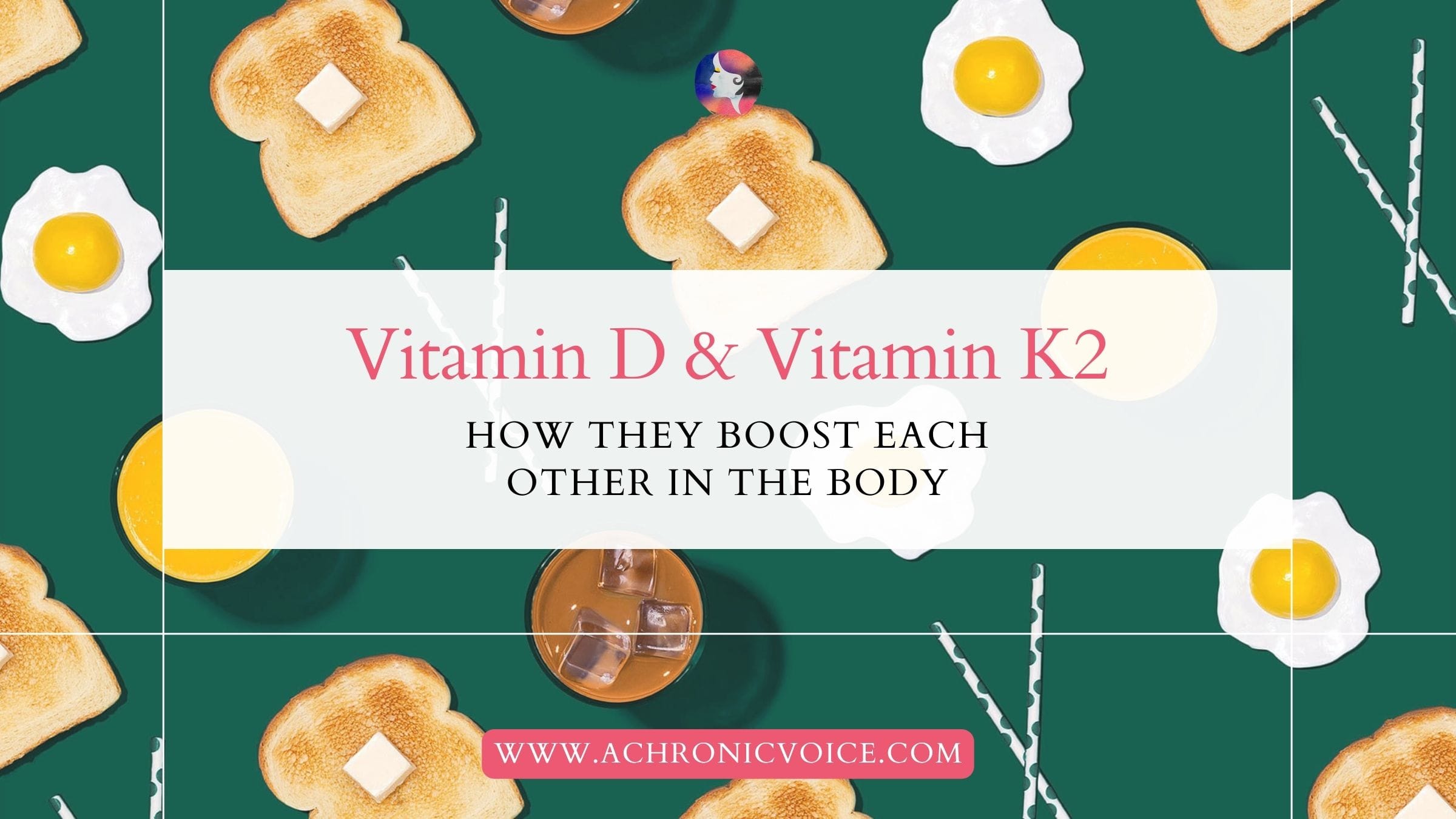

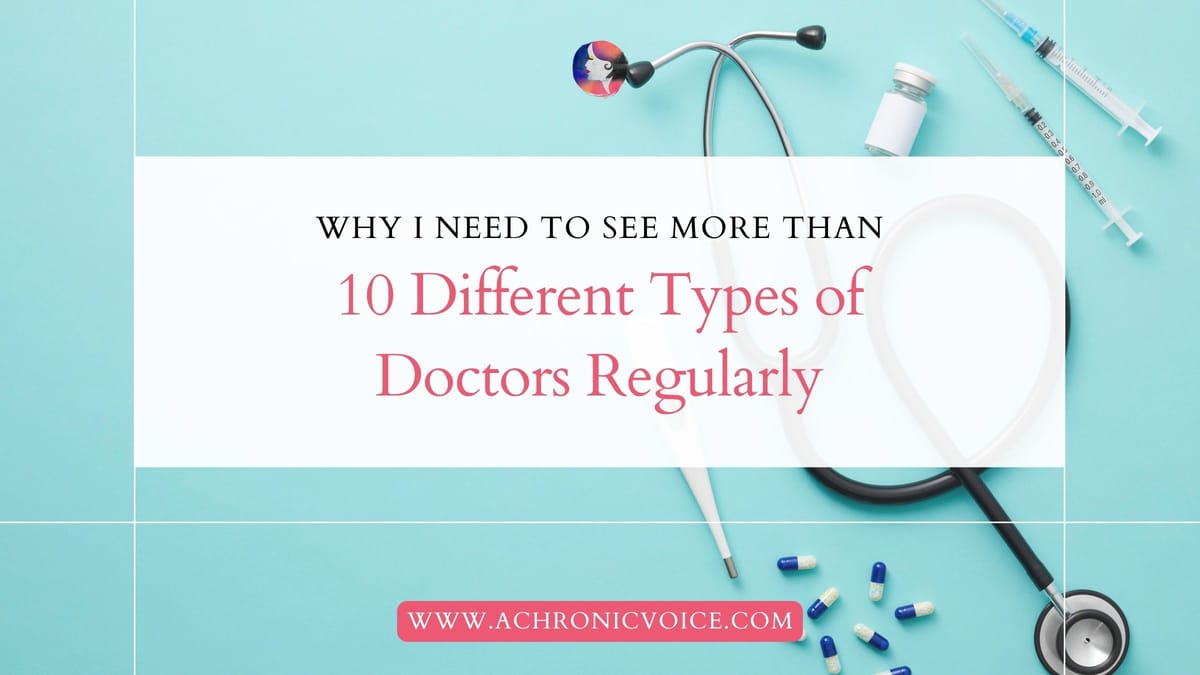
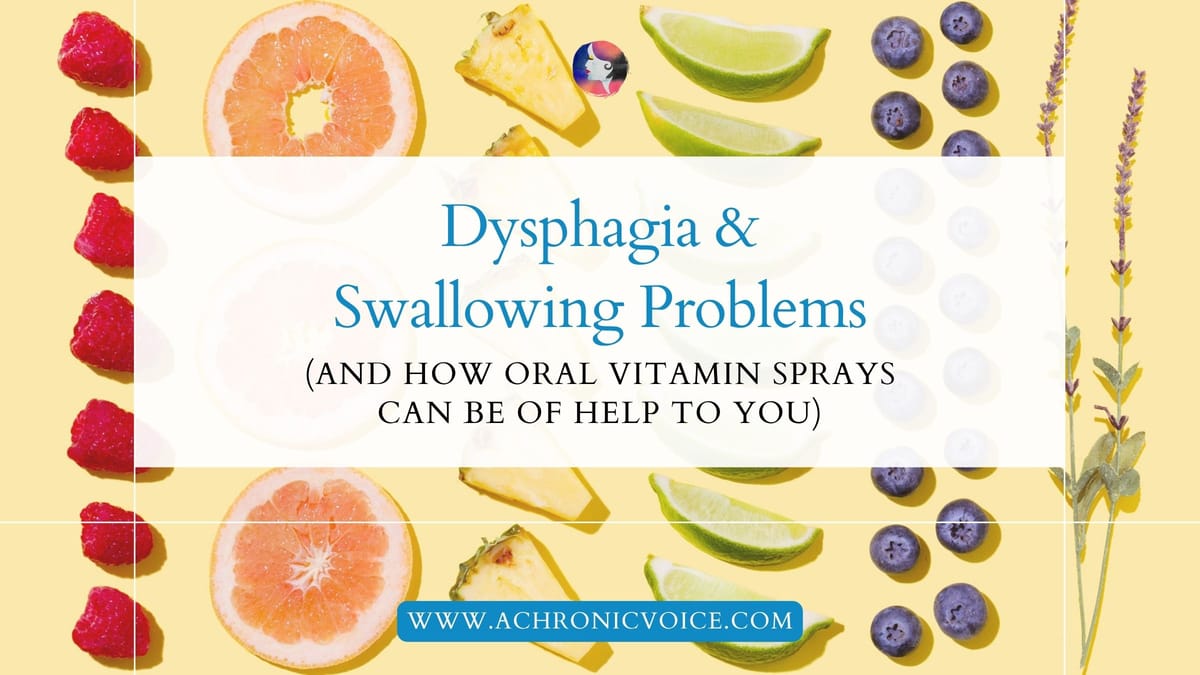
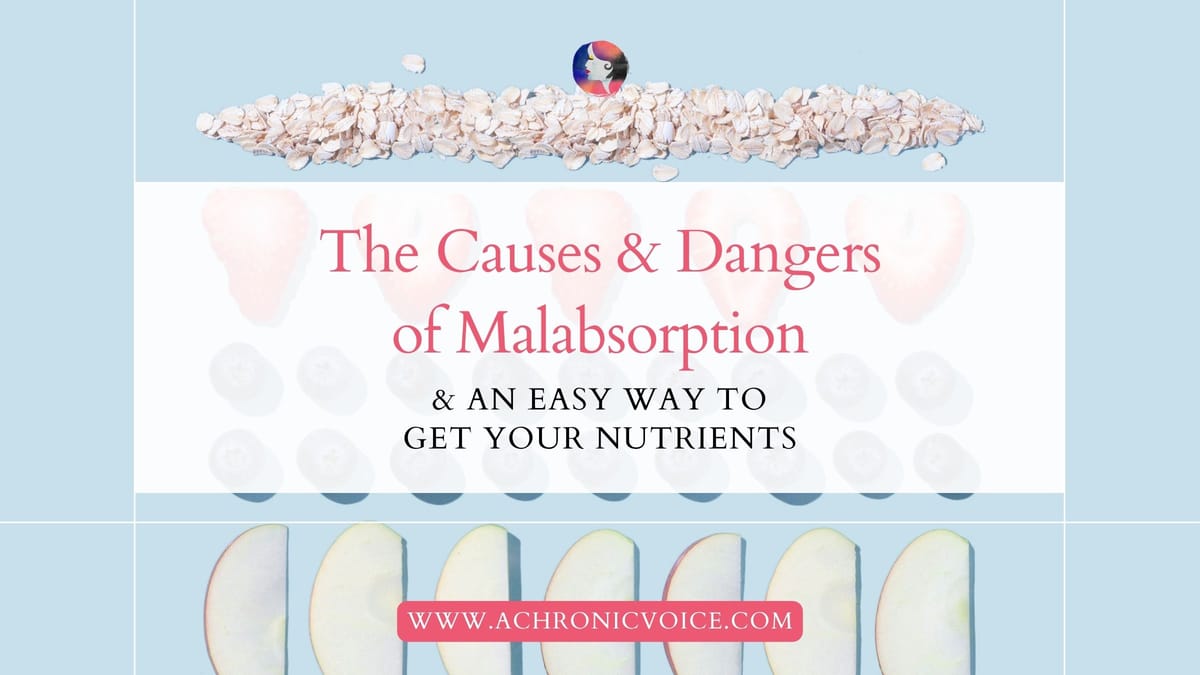
Comments Archives:
Comments imported from previous WordPress site.-
Anne
-
Sheryl Chan
-
Carrie Kellenberger
-
Sheryl Chan
-
Shruti Chopra
-
Sheryl Chan
Start a new conversation in the Member Comments below!This is such a well researched and informative article. I have learned a lot and it explains things that I was unsure of before. Now, how do I get my teenager to spend more time outside instead of sitting on her computer!
Thank you Anne! I tried my best to make it as detailed yet clear as possible, and made sure it matched the research. Haha, how about… taking the phone or computer for a walk outdoors too? ;p
Hi Sheryl! You’ve done a terrific job laying all this information out for readers in such an informative way. You hit so many points in your post that I didn’t know about until I saw it today. It’s a great idea for a post and I thank you for a terrific lesson today! Now, to go outside to sit in the sun and catch some Vit D. Hope you are taking care and doing well!
Thank you for your support as always Carrie! Haha enjoy your sun session! Yes, vitamin K is so dear to me, in a sense 🙂
This was so informative. It’s very easy to forget that we need to balance the intake of our vitamins based on the needs of our body in combination with some of the medical conditions we have and then in all that, it’s also easy to forget what each vitamin does!! This was such an important read – I didn’t realise that I didn’t know so much about Vit K.
Thank you Shruti… yes Vitamin K is so dear to me, probably the dearest, due to its interaction with my medications and blood disorder. I’m glad that this article helped!